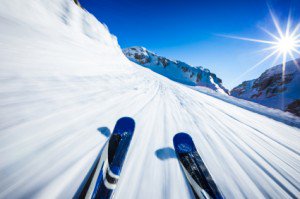When snow covers the ground, your activity level could decrease dramatically, and understandably so. Not only can it be difficult just to move in all that snow and slush, but it can be equally hard to find the motivation to do so. The problem is further complicated if you suffer from Seasonal Affective Disorder (SAD). It’s important, then, to find some winter activity that can keep you active, in shape and possibly even give you reason to be excited about all that snow.
Although many people enjoy downhill skiing and snowboarding during the winter months, these are rarely a substitute for your normal workout since they do not provide the level of exertion or type of exercise you would usually get from your routine. Cross-country skiing, on the other hand, provides a safe, accessible and effective workout in the snow.
The Basics
What is now the sport of cross-country, or Nordic, skiing originated as a mode of transportation over snowy landscapes. It can be done in a wide variety of locations. This means that you don’t necessarily have to travel long distances just to ski, as is often the case with downhill skiing. In fact, many state parks are open during the winter for cross-country skiing.
Cross-country skiing uses a complex and challenging motion to propel you forward that involves a number of major muscle groups. One of the most noticeable features of cross-country skis is that the skier’s heels are not fixed to the ski. This allows the motion of skiing to very closely resemble walking and involves your calves in the movement.
Two ski poles are also used, for both balance and forward momentum. This upper-body involvement means that cross-country skiing also works your arms, shoulders and back.
A new variation of cross-country skiing has emerged, called skate skiing, with the creation of lighter, stronger materials that allows the skier to travel much faster. As opposed to the traditional forward-and-back motion, skate skiing uses an outwards kick similar to skating. The pole plants are also larger and faster to help you cover more ground with each repetition.
Image
An Effective Winter Workout
As mentioned, both variations of cross-country skiing engage multiple large muscle groups, not just those of the legs. Because the back and shoulders are also involved, cross-country skiing is an effective way to improve strength while increasing cardiovascular fitness.
Cross-country skiing is also easy on your joints since the movement requires little-to-no impact, reducing the risk of injury.
And, let’s be honest, it’s also a very pleasant way to enjoy the great outdoors on a sunny winter’s day and see the sights with friends — all while getting a good workout in.
Both traditional and skate skiing can be a great way for runners to get outside and stay in racing shape during the winter, but skate skiing offers an added challenge. As is true of most challenging activities, though, the risk of injury is increased because of the increased speed at which you would be moving and the complexity of the movement.
For beginners, start out with traditional cross-country skiing until you become comfortable with the pole plants and basic foot motions. If you feel like you need to increase the difficulty of your workout at that point, then consider switching to skate skiing.
Potential Injuries
Even low-impact sports like cross-country skiing can come with some risk of injury and you should always use caution when starting a new sport. Cross-country skiing requires a large range of motion and considerable strength in your quadriceps and calves to keep you moving forward.
It’s recommended that you follow a basic strength training routine for at least a month before hitting the trail to make sure that your legs are up to the challenge. This can consist of just a few body weight exercises and is simply intended to acclimate your legs so that you can maintain proper form to prevent injury and soreness from skiing.
Have you been able to stay active despite the snow with cross-country skiing? Please share your experience with us in the comments.
Sources
http://impowerage.com/fitness/activities/health-benefits-of-cross-country-skiing
http://www.ncbi.nlm.nih.gov/pubmed/2694282
http://www.ncbi.nlm.nih.gov/pubmed/20947710

